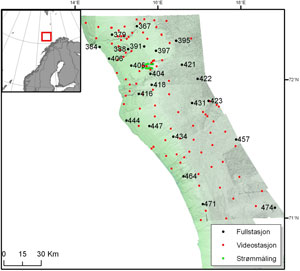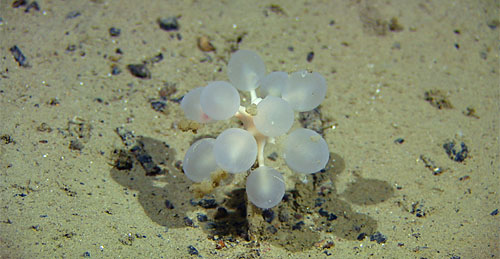
Contact
Biological mapping
Børge Holte
+47 77 60 97 53
Geological mapping
Terje Thorsnes
+47 73 90 42 75
Bathymetry
Hanne
Hodnesdal
+47 51 85 88 23
Information officer
Beate Hoddevik Sunnset
+47 55 23 85 16

Published: 16.12.2009 Updated: 24.10.2019
The MAREANO mapping in 2009 at the Eggamargin (Fig. 1) and in Nordland VII off Vesterålen/Lofoten (Fig. 2) is now completed. Altogether 129 localities were investigated during two 3 week long cruises conducting 132 video-transects (700 m long each) and 26 sampling stations.
By Lene Buhl-Mortensen

Figure 1.
The mean coverage of video-transects in the 16 000 km2 large area mapped was 8.3/1000 km2 and for sampling stations 1.6/1000 km2. In the deep areas in Nordland VII (2200-2700 m) the environment seemed homogenous. Sampling and video recording was very time-consuming and technically demanding. Fewer locations than planned were visited due to bad weather and technical problems, but the documentation of biology and geology is regarded sufficient.

Figure 2.
At the Eggamargin many of the bottom types are hard to sample and the southern areas corresponded to areas mapped earlier at the Tromsøflaket in 2006. Thus coverage with video and sampling is viewed as sufficient for ground-truthing of geology and biology. However, it would have been preferable with more video documentations and samples from some rare and special environments in the Nordland VII area. An example is the strange formations observed at 2100 m that are hard to explain both biologically and geologically.
On the northern Eggamargin many of the same biotopes that was identified by MAREANO on the Tromsøflaket area was observed. At 200-500m depth on the shelf sponge-bottoms with patches of dense sponge communities are common and here the squat lobster Munida sp. thrive. In this area trawl-marks were frequent and occurred at 51 of the 76 study sites spring survey 2009.
Another biotope is the moraines on the shelf-break with the basket star (Gorgonocephalus eucnemis). These biotopes are intersected by areas with strong currents and large sand waves. Similar sand waves has earlier been documented by MAEREANO in the Hola area. In general the fauna is poor and currents are strong in this area. In deeper water (700-900 m) in the Bjørnøya slide area the gorgonian coral Radicipes was observed for the first time in Norwegian waters. This coral occurred in relatively dense stands in a very restricted area. On the soft bottom on the slope on the Eggamargin a rich fauna of small crustaceans (Peracarida) were found living on stalks and tubes of other organisms (polychaets, crinoids, hydroids, glass sponges, etc). In this area the glass sponge Chondrocladia was much more common than in Nordland VII.

In Nordland VII were the largest depth were mapped (2700 m) and
bottom temperature is between - 0,5 and -1,1 oC the fauna was
arctic. The megafauna at these depths appears to be common for the
deep northern parts of the Atlantic and the Norwegian Sea. This
fauna was dominated by the holothurians Elpidia sp. and
Kolga hyalina, the stalked crinoid Rhizocrinus
lofotensis together with the crustaceans Bythocaris
leucopis and Saduria sp. and the sea urchin
Pourtalesia cf. jeffreysi. These species or close relatives
have been documented in recent studies from the Canadian basin. The
fauna is not species rich, but specific for the arctic deep water.
The abundance of infauna at these depths was very low. The fauna is
clearly richer on the slope shallower than 2000 m. Strange sediment
structures and bacteria coating on gravel indicates that cold seeps
may occur in certain areas at (2100 m).
In the shallow muddy areas (~150 m) off the Lofoten islands the
OSPAR listed habitat Seapens and burrowing megafauna was found.
Here the holoturian Stichopus occurred together with the
lobster Nephrops close to its northern limit of
distribution. A rich fauna was found associated with morenic ridges
as has been documented earlier from banks in the Nordland VII
area.